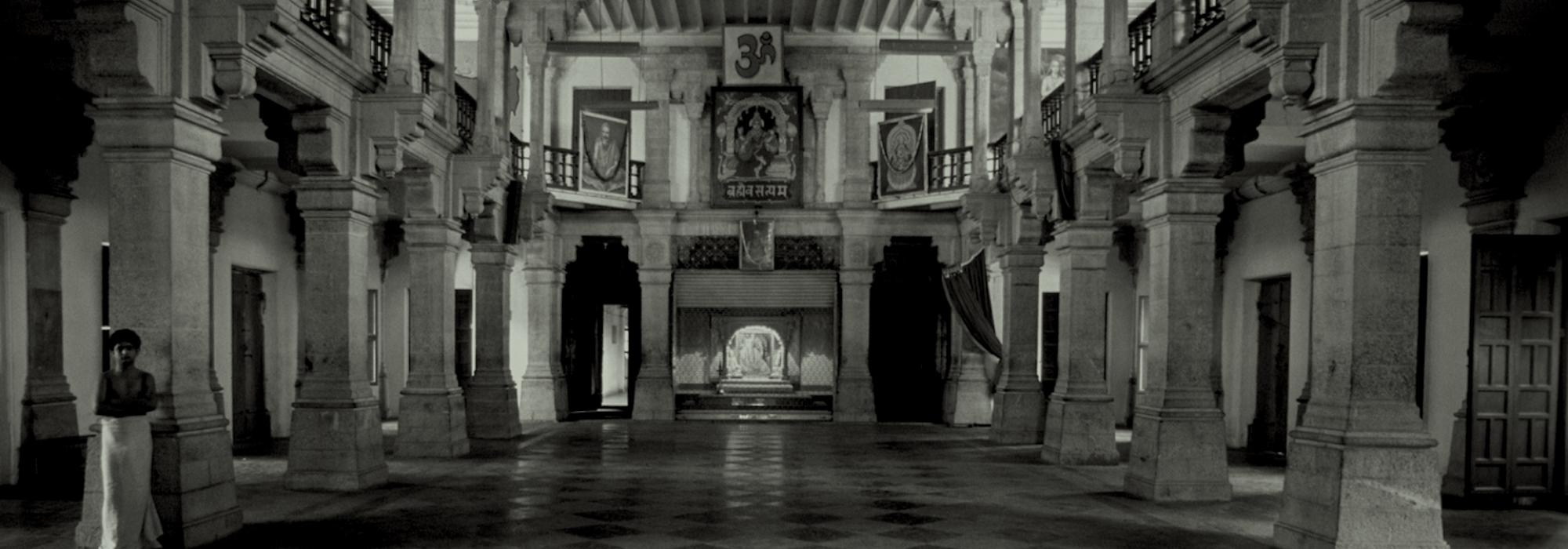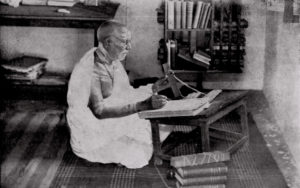Around 1922, Hanagal Virupaksha Shastri was a Vidwan in the Shankara Matha in Bangalore. He taught Advaita Vedanta. Back then his colleague was “Mimamsakanteerava” Vaidyanatha Shastri. He taught Purvamimamsa.
Both belonged to the galaxy of eminences. Not only had they touched the pinnacle in their respective Shastras, they were endowed with deep scholarship in Tarka (Logic), Vyakarana (Grammar), Sahitya (Literature), and Veda. We can regard them as the Himalayan peaks of Kanchanaganga and Gowrishankara. They were thick friends and had affection and respect for each other. It was a pleasure to watch their friendship.
When Virupaksha Shastri was a graduate student, he used to conduct discourses on the Puranas in Diwan Sir K. Seshadri Iyer’s house and earned his appreciation. This led him to give a recommendation to the Jagadguru of Sri Sringeri (Shankara Matha). Under his grace, Virupaksha Shastri turned to Vedanta from Tarka and became an expert in it in his Presence. I’ve recounted this incident elsewhere[i].
Bhashyashanti
In those days, a study circle used to take place each morning in the Shankara Matha (in Bangalore) for ordinary folks who were interested to study and pursue Vedanta for their own personal joy. Lessons in this study circle wouldn’t delve into deep philosophical (Shastric) concepts but would proceed on general lines.
Among the regulars was B.V. Lakshmana Rao. His house was very close to mine. He had a deep reverence for Vedanta and was a disciple. He repeatedly encouraged me to visit Shastri. Thanks to his kindness, I obtained the fortune of getting an initiation into Bhashyashanti (training in the commentaries on Vedanta) under the tutelage of Virupaksha Shastri.
That morning, I wore the traditional Sacred Garments, took Puja materials and went to Shastri’s home located in the Agrahara of the Shankara Matha. Shastri was engaged in his daily Puja. I performed the Sashtanga Namaskara to him, offered the plate containing the Puja materials, and sat down per his command. After keeping aside the coconut, fruits, and flowers, he asked:
V: What’s this kept in the Tamboola? [ii]
Me: A meagre Dakshina.
V: But we don’t have the tradition of accepting it? May it be taken back.
Me: But we don’t have the tradition of accepting back what is already offered?
Virupaksha Shastri laughed a bit, called a disciple and said:
“Hey, divide this into quarters and distribute it to some Brahmins in the Paathashala (traditional Vedic school)—quarters, quarters.”
The Dakshina was distributed in this manner to twenty Brahmins.
Devotion to Learning and Instruction
This was the expression of his nature. Two or three students were always present in Shastri’s home. Shastri had become a widower a long time ago. Lessons would constantly go on even during bath and mealtime. I’ve seen this with my own eyes. Grammar lessons during bath time. Tough texts on Tarka like JAgadeeshi, GAdhAdhari were taught during mealtime.
Virupaksha Shastri didn’t have regard for printed books. For him, all texts had to be on the tongue-tip. When he saw me on occasion holding a book, he would remark, “What, you’re holding the praent [print]?”
One day as he was having his meal, he was giving a discourse on Advaitasiddhi[iii] between each morsel. I was holding the printed book in my hand. It contained printing errors and I was fumbling. There was some missing alphabet in there. This became a great opportunity for Shastri.
“Saw that! This is why I say no to praent.”
All of us laughed.
******
Although he had no regard for printed books, he had enormous respect for books as such. Once when the lessons were ongoing, I put the book down on the floor, getting tired of holding it in my hand for a long time. The lesson stopped. Shastri went quiet. Unable to figure out its meaning, when I lifted my head up and looked in his direction, he said: “That text must be taken in the hand. Else may it be placed on a wooden plank. From tomorrow, may it be placed on a Vyasapeeta.[iv] If the book is placed on the floor, the lesson will halt.”
******
I obtained an extraordinary book from a friend. It was titled Tattvakaustubha authored by the eminent Bhattoji Dikshita[v]. His grammar work titled Shabdakaustubha is very renowned. Its companion is Tattvakaustubha. But in those days, I was unaware if Tattvakaustubha had been printed or no. What I had was a handwritten copy.
I mentioned this to Shastri. He was curious to have a look at it. I placed the work before him. Looking at it with his eyes, he asked: “What, its back is fitted with cloth—cardboard cloth? May it be placed there, afar. I’ll see it after I wear regular clothes.”
Accordingly, he read through the entire text cover to cover, expressed his happiness and returned it to me.
Store Accounting
If I remember it, Virupaksha Shastri used to get a monthly salary of eighty rupees from the Shankara Matha. He never touched that money with his hands. In the salary disbursement ledger at the Matha’s office, he would sign “Hanagal Virupaksha Shastri” in Devanagari script. The same day, he would visit Krishnappa at the (grocery) store near his house and ask him to draw that salary from the Matha’s office and adjust the accounts he had maintained at the store. Once every three or four months when he would see Krishnappa, he would ask:
V: What? How are our accounts doing?
K: Not much is outstanding. Some eight or ten rupees might be due. That’s about it.
V: Oh ho! Dasara will arrive anytime now---I’d need to go to the exams then. When I get that money, the dues may get cleared.
That assurance was unnecessary for Krishnappa. He would smile and with devotion, say “no worries.”
Travel
Every year, Shastri had to each visit Sringeri and Kalady once. He would inform this to me a week before the date of the journey. I would place a request accordingly to the chief of the Railway Police, Rao Saheb K. Srinivasan. He in turn would convey this news to the Station Master at Arasikere.
The Bangalore train would typically reach Arasikere at six in the evening. At exactly that hour, a servant would show up at the train and receive Shastri. Shastri would immediately disembark and go with him to the well nearby. The servant would’ve already arranged for these items: a metal pot, a cord, a copper vessel, some tamarind and a bit of soil.
Shastri would draw water from the well, clean the vessels, draw water again, and perform his (evening) Sandhyavandanam. After offering the Arghya[vi] he would return to his seat in the train. This evening Sandhyavandanam would be performed without fail.
For this help, he would offer profuse thanks to everyone—mouthfuls of profuse gratitude.
To be continued...
This episode is a part of the iconic D.V. Gundappa’s series of pen portraits in the volume titled Vaidikadharma Sampradaayastharu (Traditional Vedic Scholars) forming part of his acclaimed Jnapaka Chitrashaale (The Art Gallery of Memories).
Footnotes
[i] Jnapaka Chitrashaale Volume IV
[ii] Tamboola is a traditional auspicious offering consisting of two betel leaves and betel nuts and money.
[iii] Authored by the 16th—17th Century Bengali Advaita scholar and philosopher Madhusudana Saraswati
[iv] A two-legged foldable wooden book stand traditionally used in India during studies.
[v] The famed 17th Century Maharashtrian Sanskrit grammarian who also authored the Siddhanta Kaumudi.
[vi] Offering water to the Sun















































